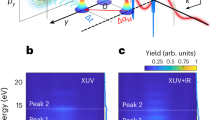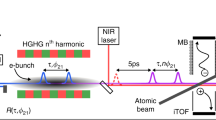Abstract
The time it takes a bound electron to respond to the electromagnetic force of light sets a fundamental speed limit on the dynamic control of matter and electromagnetic signal processing. Time-integrated measurements of the nonlinear refractive index1 of matter indicate that the nonlinear response of bound electrons to optical fields is not instantaneous; however, a complete spectral characterization of the nonlinear susceptibility tensors2—which is essential to deduce the temporal response of a medium to arbitrary driving forces using spectral measurements—has not yet been achieved. With the establishment of attosecond chronoscopy3,4,5, the impulsive response of positive-energy electrons to electromagnetic fields has been explored through ionization of atoms6 and solids7 by an extreme-ultraviolet attosecond pulse8 or by strong near-infrared fields9,10,11. However, none of the attosecond studies carried out so far have provided direct access to the nonlinear response of bound electrons. Here we demonstrate that intense optical attosecond pulses synthesized in the visible and nearby spectral ranges allow sub-femtosecond control and metrology of bound-electron dynamics. Vacuum ultraviolet spectra emanating from krypton atoms, exposed to intense waveform-controlled optical attosecond pulses, reveal a finite nonlinear response time of bound electrons of up to 115 attoseconds, which is sensitive to and controllable by the super-octave optical field. Our study could enable new spectroscopies of bound electrons in atomic, molecular or lattice potentials of solids12, as well as light-based electronics operating on sub-femtosecond timescales and at petahertz rates13,14,15.
This is a preview of subscription content, access via your institution
Access options
Subscribe to this journal
Receive 51 print issues and online access
$199.00 per year
only $3.90 per issue
Buy this article
- Purchase on Springer Link
- Instant access to full article PDF
Prices may be subject to local taxes which are calculated during checkout




Similar content being viewed by others
References
Sheik-Bahae, M., Hutchings, D. C., Hagan, D. J. & Van Stryland, E. W. Dispersion of bound electron nonlinear refraction in solids. IEEE J. Quantum Electron. 27, 1296–1309 (1991)
Boyd, R. W. Nonlinear Optics Ch. 1 (Academic Press, 1992)
Hentschel, M. et al. Attosecond metrology. Nature 414, 509–513 (2001)
Niikura, H. et al. Sub-laser-cycle electron pulses for probing molecular dynamics. Nature 417, 917–922 (2002)
Corkum, P. B. & Krausz, F. Attosecond science. Nature Phys . 3, 381–387 (2007)
Schultze, M. et al. Delay in photoemission. Science 328, 1658–1662 (2010)
Cavalieri, A. L. et al. Attosecond spectroscopy in condensed matter. Nature 449, 1029–1032 (2007)
Goulielmakis, E. et al. Single-cycle nonlinear optics. Science 320, 1614–1617 (2008)
Uiberacker, M. et al. Attosecond real-time observation of electron tunnelling in atoms. Nature 446, 627–632 (2007)
Eckle, P. et al. Attosecond ionization and tunneling delay time measurements in helium. Science 322, 1525–1529 (2008)
Shafir, D. et al. Resolving the time when an electron exits a tunnelling barrier. Nature 485, 343–346 (2012)
Ivanov, M. & Smirnova, O. Opportunities for sub-laser-cycle spectroscopy in condensed phase. Chem. Phys. 414, 3–9 (2013)
Krüger, M., Schenk, M. & Hommelhoff, P. Attosecond control of electrons emitted from a nanoscale metal tip. Nature 475, 78–81 (2011)
Schiffrin, A. et al. Optical-field-induced current in dielectrics. Nature 493, 70–74 (2013)
Schultze, M. et al. Controlling dielectrics with the electric field of light. Nature 493, 75–78 (2013)
Weiner, A. M. Ultrafast Optics Ch. 6 (John Wiley & Sons, 2009)
Zewail, A. H. Femtochemistry: atomic-scale dynamics of the chemical bond. J. Phys. Chem. A 104, 5660–5694 (2000)
Goulielmakis, E. et al. Real-time observation of valence electron motion. Nature 466, 739–743 (2010)
Smirnova, O. et al. High harmonic interferometry of multi-electron dynamics in molecules. Nature 460, 972–977 (2009)
Zewail, A. H. Femtochemistry: Ultrafast Dynamics of the Chemical Bond Vol. 1 (World Scientific, 1994)
Dudovich, N. et al. Measuring and controlling the birth of attosecond XUV pulses. Nature Phys . 2, 781–786 (2006)
Wirth, A. et al. Synthesized light transients. Science 334, 195–200 (2011)
Hassan, M. Th. et al. Invited Article: attosecond photonics: synthesis and control of light transients. Rev. Sci. Instrum. 83, 111301 (2012)
Sansone, G., Poletto, L. & Nisoli, M. High-energy attosecond light sources. Nature Photon . 5, 655–663 (2011)
Vampa, G. et al. Linking high harmonics from gases and solids. Nature 522, 462–464 (2015)
Hohenleutner, M. et al. Real-time observation of interfering crystal electrons in high-harmonic generation. Nature 523, 572–575 (2015)
Corkum, P. B. Plasma perspective on strong field multiphoton ionization. Phys. Rev. Lett. 71, 1994–1997 (1993)
Krausz, F. & Ivanov, M. Attosecond physics. Rev. Mod. Phys. 81, 163–234 (2009)
Muller, H. G. An efficient propagation scheme for the time-dependent Schrödinger equation in the velocity gauge. Laser Phys. 9, 138–148 (1999)
Gauthey, F. I., Garraway, B. M. & Knight, P. L. High harmonic generation and periodic level crossings. Phys. Rev. A 56, 3093–3096 (1997)
Lundeen, T., Hou, S. Y. & Nibler, J. W. Nonresonant third order susceptibilities for various gases. J. Chem. Phys. 79, 6301–6305 (1983)
Shelton, D. P. Nonlinear-optical susceptibilities of gases measured at 1064 and 1319 nm. Phys. Rev. A 42, 2578–2592 (1990)
Harris, S. E. & Sokolov, A. V. Subfemtosecond pulse generation by molecular modulation. Phys. Rev. Lett. 81, 2894–2897 (1998)
Baker, S., Walmsley, I. A., Tisch, J. W. G. & Marangos, J. P. Femtosecond to attosecond light pulses from a molecular modulator. Nature Photon . 5, 664–671 (2011)
Blow, K. J. & Wood, D. Theoretical description of transient stimulated Raman scattering in optical fibers. IEEE J. Quantum Electron. 25, 2665–2673 (1989)
Coleman, T. F. & Li, Y. Y. An interior trust region approach for nonlinear minimization subject to bounds. SIAM J. Optim. 6, 418–445 (1996)
Acknowledgements
This work was supported by European Research Council grant (Attoelectronics-258501), the Deutsche Forschungsgemeinschaft Cluster of Excellence: Munich Centre for Advanced Photonics (http://www.munich-photonics.de), the Max Planck Society and the European Research Training Networks ATTOFEL and MEDEA, the Russian Foundation for Basic Research (projects numbers 13-02-01465, 13-02-92115 and 13-04-40335) and the Welch Foundation (grant number A-1801).
Author information
Authors and Affiliations
Contributions
M.Th.H., T.T.L., A.M. and M.G. conducted the experiments; O.R. and V.P. developed the dispersive optics for the experiments; E.G. planned the experiments and supervised the project; M.Th.H., T.T.L., P.Z., A.M. and N.K. conducted the simulations; and M.Th.H., T.T.L., A.M., A.M.Z., F.K. and E.G. interpreted the data and contributed to the preparation of the manuscript.
Corresponding author
Ethics declarations
Competing interests
The authors declare no competing financial interests.
Extended data figures and tables
Extended Data Figure 1 Supercontinuum spectra and experimental set-up.
a, The supercontinuum spectra spans more than two octaves (1.1–4.6 eV), and is shown by the black line; the spectra of the individual channels ChNIR, Chvis, Chvis-UV and ChDUV are shown by the red, orange, blue and violet lines, respectively. b, Schematic illustration of the experiment set-up.
Extended Data Figure 2 Spectral equalization by a metal–dielectric–metal (MDM) coating.
a, The designed reflectivity (red line) and spectral phase (black) of the MDM coating applied on the outer mirror of the double mirror module shown in Extended Data Fig. 1. b, Multi-octave spectrum at the exit of the synthesizer (red line) and upon reflection off the MDM mirror (black line).
Extended Data Figure 3 Global phase and CEP difference in a sub-cycle regime.
a, Half-cycle, cosine-like (blue line) and sine-like (red line) waveforms, compared with the carrier wave (dotted blue and red lines) and envelope (dashed blue lines). b, Limits of CEP decomposition in the time domain. Retrieved CEP (solid lines) versus global-phase offset (dashed lines) as a function of the ratio between the FWHM of the intensity envelope and the period of the carrier wave for ϕG = π/4 rad (blue line), ϕG = π/2 rad (green line) and ϕG = 3π/4 rad (red).
Extended Data Figure 4 Simulated global-phase spectrograms.
a, b, Calculated global-phase (ϕG) spectrograms using the adiabatic model (a) and the TDSE model (b) for experimentally sampled waveforms (optical attosecond pulse) and an intensity of about 4 × 1013 W cm−2. c, Simulated global-phase spectrograms for a sub-cycle pulse (about 2 fs; shown in inset). The polarization response is insensitive to global-phase variation of the waveform; see also experiments in Fig. 3. The colour scale represents the spectral intensity in arbitrary units.
Extended Data Figure 5 Nonlinearity study of the interaction of an optical attosecond pulse with a Kr atom.
a–d, Data points show the spectrally integrated yield of the nonlinear polarization (0–8 eV) as a function of the intensity of the optical attosecond pulse for two global phases ϕG of the driving waveform, ϕG ≈ 0 (a, c) and ϕG ≈ π/2 rad (b, d), evaluated from TDSE simulations (a, b) and our experiments in Fig. 4 (c, d). The error bars represent the standard error of the mean of the input field intensity and the calculated integrated spectral yield of the nonlinear polarization. Δ is the slope of the linear fitting of the log–log plots; the errors shown indicate the standard error of mean, with n = 3. Insets show temporal profiles of the driving electric fields in arbitrary units.
Extended Data Figure 7 Synthetic global-phase spectrograms and nonlinear dipole fittings.
a–c, Synthetic global-phase (ϕG) spectrograms determined using the simple model (equation (1) with the same set of parameters (a, b, c) and delays dt = 0 as (a), dt = 20 as (b) and dt = 30 as (c). The colour scale represents spectral intensity in arbitrary units. d, e, Fits (red lines) of the spectrally filtered (d, 5.5–8 eV; e, 0–8 eV) nonlinear dipoles (ρ(t), black lines) with ϕG ≈ 0 (left column) and ϕG ≈ π/2 rad (right column) using equation (1) and 6 × 1013 W cm−2.
Extended Data Figure 8 Reconstruction of the global-phase spectrogram calculated by the TDSE model.
a, Calculated spectrogram at different global-phase settings (ϕG = −1.2π−1.2π rad) of the optical attosecond pulse using the TDSE model. b, Reconstructed spectrogram using the model of equation (1). The colour bar represents spectral intensity in arbitrary units. c, d, Calculated nonlinear dipoles using the TDSE model at ϕG ≈ 0 (c) and ϕG ≈ π/2 rad (d) are plotted in black; the reconstructed nonlinear dipoles and the adiabatic dipoles are shown in red and blue, respectively.
Extended Data Figure 9 Intensity dependence of the nonlinear dipole delay.
a, b, The delay between the adiabatic dipole and the calculated dipole using the TDSE model as a function of the peak intensity according to TDSE simulations (a) and evaluated from the experimental data (b; see Fig. 4).
Rights and permissions
About this article
Cite this article
Hassan, M., Luu, T., Moulet, A. et al. Optical attosecond pulses and tracking the nonlinear response of bound electrons. Nature 530, 66–70 (2016). https://doi.org/10.1038/nature16528
Received:
Accepted:
Published:
Issue Date:
DOI: https://doi.org/10.1038/nature16528
This article is cited by
-
Dynamics of microcavities created by nonharmonic unipolar light pulses in a resonant medium
Applied Physics B (2024)
-
Unconventional light - matter interaction in the response-time region of unionized bound electrons
Applied Physics B (2024)
-
350-2500 nm supercontinuum white laser enabled by synergic high-harmonic generation and self-phase modulation
PhotoniX (2023)
-
Intense ultraviolet–visible–infrared full-spectrum laser
Light: Science & Applications (2023)
-
Attosecond field emission
Nature (2023)
Comments
By submitting a comment you agree to abide by our Terms and Community Guidelines. If you find something abusive or that does not comply with our terms or guidelines please flag it as inappropriate.



